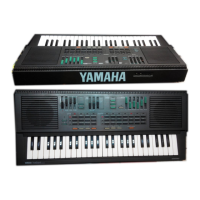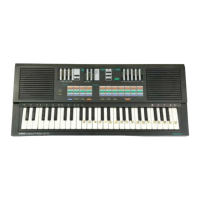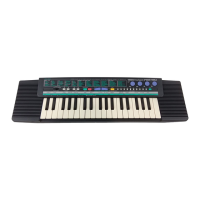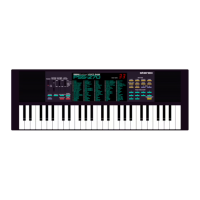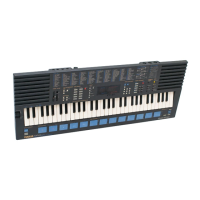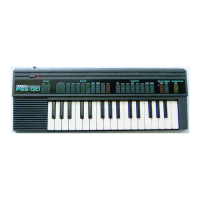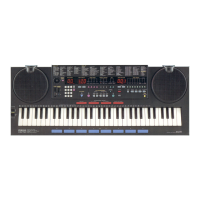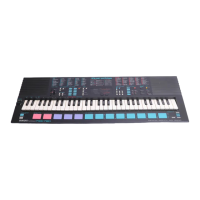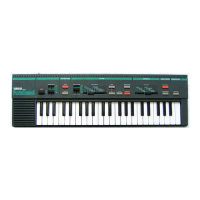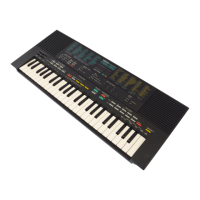
Do you have a question about the Yamaha PortaSound PSS-480 and is the answer not in the manual?
| Custom Drummer | Yes |
|---|---|
| Type | Digital Keyboard |
| Keyboard | 49 keys |
| Speakers | Yes |
| Display | LCD |
| Preset Voices | 100 |
| Rhythms | 100 rhythms |
| MIDI | In/Out |
| Power Supply | 6 x C batteries |
| Polyphony | 8-note |
Highlights the advanced microcomputer control and versatile functions of the PortaSound PSS-480 keyboard.
Explains the manual's organization into three parts for easy learning of the keyboard's features.
Provides guidelines on avoiding heat, humidity, dust, and improper handling to prevent instrument damage.
Details on using AC adaptors and maintaining batteries to ensure proper function and memory preservation.
Instructions on cleaning the instrument exterior with a soft, dry cloth to preserve its finish.
Advises against using the PortaSound near TVs or other equipment that may cause interference.
States that the instrument has no user-serviceable parts and directs all repairs to qualified personnel.
Explains how to use batteries or an AC adaptor to power the PortaSound PSS-480.
Basic steps to turn on the instrument, adjust volume, and start playing the keyboard.
Instructions on how to activate and listen to the pre-programmed demonstration song.
Guides users on how to choose instrument sounds and rhythm styles using the VOICE/STYLE LIST and buttons.
Explains how to add special effects to sounds and adjust the rhythm/accompaniment tempo.
Covers Single Finger Chords and Automatic Accompaniment functions for easy chord playing.
Details on starting, stopping, and varying rhythms using controls like START/STOP and INTRO/FILL IN.
Overview of the keyboard's structure, divided into Voice/Melody, Rhythm, and Auto Accompaniment sections.
Details on preset voices, effects, and easy play functions like Transpose for the melody section.
Explains how to play rhythm patterns and use Auto Accompaniment for bass, chords, and orchestra.
Step-by-step guide on choosing instrument sounds using the VOICE LIST and number buttons.
Describes the Vibrato, Sustain, and Reverb effects and their impact on instrument sounds.
Explains the Portamento effect for smooth pitch gliding and how to adjust its speed.
Details on how to raise or lower the keyboard pitch by semitones for easier playing.
How to enable the Duet feature to add a harmonizing second voice to your melody.
Guide on raising or lowering the overall pitch in steps for playing with other instruments.
Instructions on adjusting the melody section's volume relative to the auto accompaniment.
How to choose from 100 basic rhythm styles using the STYLE LIST and number buttons.
Guides on starting, stopping, and varying rhythms using the RHYTHM CONTROL section buttons.
Explains how to set the tempo and interpret the BEAT indicators for rhythm patterns.
Introduction to playing percussion sounds live and damping the open hi-hat.
Details on creating and memorizing original rhythm patterns using the Custom Drummer function.
Step-by-step guide for programming and saving unique rhythm patterns.
Explains how to erase, add, accent, or create drum rolls within a custom pattern.
Describes the NORMAL, SINGLE FINGER, and FINGERED modes for auto accompaniment.
Explains how to turn on/off rhythm, bass, chord, and orchestra parts of the accompaniment.
Details on playing major and minor chords using the Single Finger Chord function.
Explains how to play seventh and minor seventh chords with the Single Finger Chord function.
Instructions on how to initiate and end the auto accompaniment sequence.
Details on how to play three or four-note chords for accompaniment.
Guide to enabling the Duet feature for a harmonizing second voice during performance.
Information on storing and playing back monophonic melodies and recorded data.
Details on recording and playing back chord progressions and accompaniment data.
Step-by-step instructions for recording melodies into the SONG MEMORY banks.
Guide on how to record chord progressions, including timing and style information.
Instructions on how to initiate playback of recorded chord progressions.
Introduction to creating original sounds using FM synthesis and voice parameters.
A fundamental guide to FM synthesis, including voice parameters and basic theory.
Details on how Attack and Decay rates influence the volume envelope of sounds.
Explains how Frequency ratios and Feedback Level affect pitch and tonal quality.
Describes Modulation Level for sound brightness and Total Level for overall volume.
Explains MIDI as a standard interface for musical instruments to communicate.
Details the MIDI IN and OUT terminals and the use of MIDI cables for connections.
Guide on switching between Keyboard Assign (00) and Sound Source (99) modes.
Details on transmitting performance data and controlling external MIDI equipment.
Explains how MIDI transmits program changes, control data like vibrato, sustain, and portamento.
Procedure for transferring all internal data to an external MIDI memory device.
Details on received MIDI note, program, and control data, including channel usage.
How the PSS-480 acts as a multi-timbral sound source controlled by external MIDI.
Instructions for setting MIDI receive channels and selecting the transmit channel.
Steps to reset all instrument settings and memory to factory defaults.
Details on the keyboard range, voice list, and available rhythm styles.
Lists key features like Auto Accompaniment, Song Memory, Effects, and Synthesizer parameters.
Information on MIDI functions, ports, and auxiliary connections like headphones.
Provides dimensions, weight, and speaker specifications for the PortaSound.
Explains the structure and format of exclusive MIDI data for voice and pattern storage.
Details the format for melody data, including duration, key on/off, and voice change.
Explains parameters like pitch bend, effect status, and other settings for melody data.
Defines the format for chord sequence data, including root notes, chord types, and measure counts.
Describes format for rhythm control, melody memory switches, orchestration, style, and tempo.
Details the format for rhythm data, including bank number, beat length, and instrument selection.
Explains timing data, quantize flags, volume data, and accent settings for rhythm patterns.
Details on default channel assignments, mode transmissions, and recognized messages.
Information on transmitted and recognized note on/off data and velocity sensitivity.
Covers transmitted and recognized control changes, system exclusive, and real-time messages.
Details MIDI implementation for Mode 99, including channel assignments and recognized data.
Covers transmitted and recognized control changes, system exclusive, and real-time messages for Mode 99.
Details on FCC rules compliance and measures to resolve radio/TV interference issues.
Note on international distribution and varying warranty conditions by marketing area.
